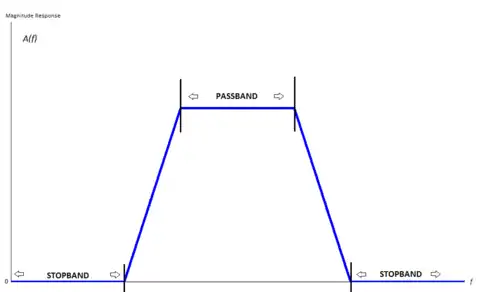Stopband
A stopband is a band of frequencies, between specified limits, through which a circuit, such as a filter or telephone circuit, does not allow signals to pass, or the attenuation is above the required stopband attenuation level.[1] Depending on application, the required attenuation within the stopband may typically be a value between 20 and 120 dB higher than the nominal passband attenuation, which often is 0 dB.

The lower and upper limiting frequencies, also denoted lower and upper stopband corner frequencies, are the frequencies where the stopband and the transition bands meet in a filter specification. The stopband of a low-pass filter is the frequencies from the stopband corner frequency (which is slightly higher than the passband 3 dB cut-off frequency) up to the infinite frequency. The stopband of a high-pass filter consists of the frequencies from 0 hertz to a stopband corner frequency (slightly lower than the passband cut-off frequency).
A band-stop filter has one stopband, specified by two non-zero and non-infinite corner frequencies. The difference between the limits in the band-stop filter is the stopband bandwidth, which usually is expressed in hertz.
A bandpass filter typically has two stopbands. The shape factor of a bandpass filter is the relationship between the 3 dB bandwidth, and the difference between the stopband limits.
See also
- Passband
- Band-stop filter
- Band gap in solid state physics
- Band rejection
References
2.![]() This article incorporates public domain material from Federal Standard 1037C. General Services Administration. Archived from the original on 2022-01-22. (in support of MIL-STD-188).
This article incorporates public domain material from Federal Standard 1037C. General Services Administration. Archived from the original on 2022-01-22. (in support of MIL-STD-188).